White Bean & Mushroom Stew with Thyme
People often ask me how long it takes me to make a blog post. The short answer is: it depends. Some dishes take longer to prepare than others. Some foods look naturally good (like fruits and vegetables), while others need a little help (and time) to look appetizing (such as beans or tempeh, for instance). Sometimes, I know straight away what I want to do when it comes to photograph the dishes I prepare – I kind of have the pictures I want to take in mind –; other times, I have no clue of what I’m going to do.
Having said all this, I think stews such as the one I’m sharing with you today are the hardest meals to photograph. I love this kind of food, but stews in general look like an indiscernible (but incredibly tasty) mess of ingredients and are usually brown-ish in colour. This particular one demanded a lot of work. I cooked and shoot the recipe in the morning, but then, in the early afternoon, I looked at the images and wasn’t pleased. I ended up starting all over again, only to get images that I’m just relatively happy with.
But when it comes to how the dish tastes though, that’s a whole different story. I actually make this kind of mushroom and bean stew very often because of how easy, quick and tasty it is. The addition of brewer’s yeast (you could use nutritional yeast instead) gives it complexity and complements the mushrooms’ earthy flavour beautifully. You don’t have to stick to the varieties I used here – shiitakes or the regular white button mushrooms work well too.
White Bean & Mushroom Stew with Thyme
serves 3, as a main
1 Tablespoon olive oil
1 large / 180 g onion, thinly sliced
4 garlic cloves, minced
300 g baby Portobello mushrooms, sliced
285 g pleurothus mushrooms, roughly chopped
6 thyme sprigs
255 g / 1 ½ cups cooked white beans
310 ml / 1 ¼ cups water
2 Tablespoons brewer’s yeast
2 Tablespoons lemon juice
3 Tablespoons tomato puree
½ teaspoon salt
2 teaspoons cassava starch (or corn starch)
Heat the oil in a large skillet over medium heat. Add the onion and garlic and cook until the onion is soft (about 5 minutes). Add the mushrooms and thyme sprigs and cook, stirring often, for additional 10 minutes, or until the mushrooms shrink considerably.
In a medium sized bowl, combine the water, brewer’s yeast, lemon juice and tomato puree. In another bowl, gradually mix the cassava starch with ¼ cup of the brewer’s yeast and tomato sauce. Add the cassava mixture back to the bowl with the sauce and whisk until thoroughly combined.
Add the beans and the sauce to the skillet with the mushrooms and let it boil for 5 minutes or until the sauce thickens and reduces a bit. Remove the thyme sprigs and serve immediately with crusty bread on the side.
Red Lentil and Cauliflower Stew
As I’ve mentioned here countless times, autumn is my favourite season. Unlike most people, I like cold weather and absolutely love one-pot and soul warming stews and soups. This stew in particular is the kind of dish I often cook when colder days arrive, as it’s quick to make and I most likely already have all the ingredients I need for it in the pantry.
It’s also very versatile: sometimes I use zucchini in place of the cauliflower and, even though I prefer the latter, it tastes lovely too. Other times, I substitute the water for coconut milk (or half of the amount of water) for a richer, creamier version. As with most curries and stews, this one tastes better the day after it’s made. The recipe below makes plenty of food, so I’m sure you’ll end up with leftovers for the next meal. I also really like to serve this dish with steamed brown rice (to soak up the sauce) and plenty of toasted cashews on top.
Red Lentil and Cauliflower Stew
(serves 4 to 6)
1 teaspoon cumin seeds
1 teaspoon coriander seeds
1 teaspoon mustard seeds
4 garlic cloves, minced
2 Tablespoons olive oil
1 medium red chilli, finely chopped
210 g / 1 cup red lentils
375 ml / 1 ½ cups chopped canned tomatoes
500 ml / 2 cups water
175 g / 3 medium carrots, cubed
350 g / 1 medium cauliflower, cut into florets
salt and black pepper to taste
In a dry skillet over medium heat, toast the seeds for 5-6 minutes or until fragrant and lightly toasted. Transfer the seeds to a mortar and pestle and mash them until they’re finely ground.
In a medium-sized pan over medium heat, heat the olive oil. Add the garlic, chilli, spices and carrots and fry for 1 minute or 2. Now add the lentils, canned tomatoes, water and cauliflower and bring the mixture to a boil. Once boiling, reduce the heat to low-medium, cover the pan and cook for 25-30 minutes or until the vegetables are tender. At the last minute of cooking, add the salt (start with ½ teaspoon, taste, and increase if you need) and black pepper.
Beet and Lentil Stew with Sweet Onions
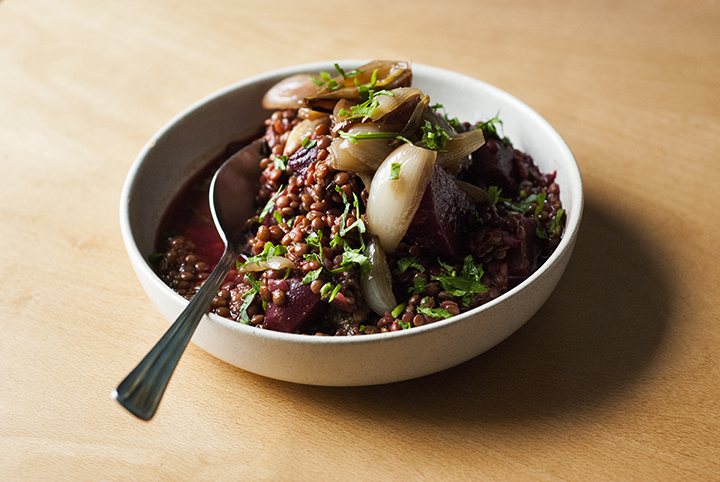 When I was younger, my mom would cook for me a few times, particularly if I was busy studying. She didn’t like to cook, but there were a couple of dishes she made that I absolutely loved. One of them consisted, basically, of beets and onions. She’d use those pre-cooked beets they sell on the supermarkets and sautée them in olive oil along with roughly chopped onions. At the very last minute of cooking, soy sauce and a good splash of red wine vinegar were stirred in. The final dish looked terribly unappetising but tasted incredibly good. The sweet and caramelised onions were a nice contrast to the chunks of beetroot, and the light sourness the red wine vinegar coated the vegetables with really sold the deal for me.
When I was younger, my mom would cook for me a few times, particularly if I was busy studying. She didn’t like to cook, but there were a couple of dishes she made that I absolutely loved. One of them consisted, basically, of beets and onions. She’d use those pre-cooked beets they sell on the supermarkets and sautée them in olive oil along with roughly chopped onions. At the very last minute of cooking, soy sauce and a good splash of red wine vinegar were stirred in. The final dish looked terribly unappetising but tasted incredibly good. The sweet and caramelised onions were a nice contrast to the chunks of beetroot, and the light sourness the red wine vinegar coated the vegetables with really sold the deal for me.
I haven’t eaten the onion and beetroot stir-fry for a couple of years now. Not that I couldn’t make it myself, but simply because I know that, if I made it, it wouldn’t taste like hers. It’s funny how we attach feelings to food and food to memories, and how those connections can indeed have an impact on our palates. As much as we might want to rationalise the experience of eating, there’s no way we can judge and evaluate food without our personal beliefs and stories sneaking in unconsciously.
The other day, I was reminded of the beetroot-onion dish while watching Nigel Slater cooking. He was making a really good-looking lentil stew with caramelised onions on top. The moment I saw it, I knew I had to make my version of it. And, as it turns out, my version is a mix of mom’s signature dish and Nigel’s recipe. Personally, I think it tastes divine. The key is to choose the right lentils – use a variety that doesn’t collapse while cooking, such as Puy, for some texture. Equally important is not to skip the cinnamon, as it gives the stew that comforting and warming character all winter meals should have.
Beet and Lentil Stew with Sweet Onions
(serves 4, as a main)
For the stew:
635 gr / 6 medium sized beets, peeled and quartered
315 g green or puy lentils / 1 ½ cups
1 large onion / 180 g cut into thin half moons
4 garlic cloves, finely chopped
2 tablespoons olive oil
1 teaspoon sweet paprika
½ teaspoon cinnamon
1/8 teaspoon freshly grated nutmeg
½ teaspoon salt
625 ml / 2 ½ cups reduced sodium vegetable stock
625 ml / 2 ½ cups water
1 bunch / 12 g parsley, finely chopped
For the sweet onion topping:
470 g / 7 small onions, peeled and quartered
1 tablespoon olive oil
1 tablespoon red wine vinegar
salt to taste
freshly grated nutmeg to taste
In a large pot over over low-medium heat, add the olive oil, garlic and onion. Fry for 2-3 minutes or until the onion is soft and translucent. Add the paprika, cinnamon and nutmeg and fry for one additional minute.
Add the beets, the stock and the water to the pan and bring everything to a boil. Once boiling, decrease the heat to low-medium and cook, covered, for 30 minutes.
After half an hour, add the lentils and the parsley. Simmer for additional 30 minutes. When the lentils are cooked, stir in the salt and serve with the onion topping (recipe follows) and cooked brown rice.
For the sweet onion topping: add, to a non-stick frying pan over low-medium heat, the olive oil, onions and a pinch of salt. Put a lid over the pan and let the onions cook for 20 minutes, stirring occasionally, until they’re caramelised. At the very last minute of cooking, add the nutmeg and the red wine vinegar. Give everything a good stir and serve over the stew.
Recipe inspired by Nigel Slater
Mung Bean and Kale Stew with Miso
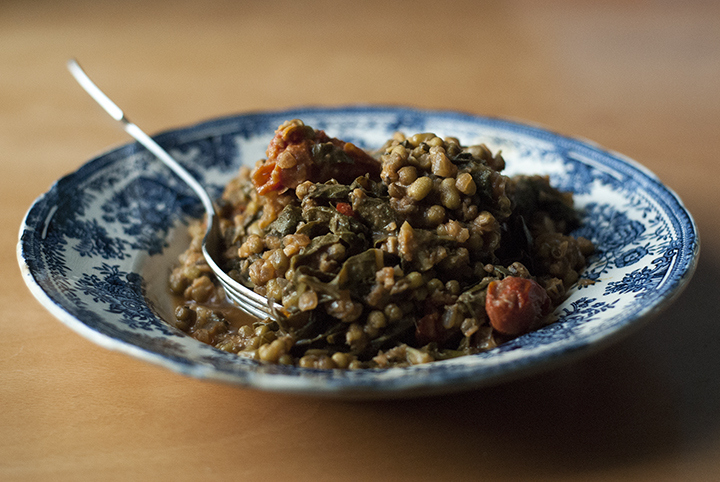
Miso is the kind of ingredient you either love or hate. There’s no middle ground. I strongly believe that those who don’t like it should give it a second chance, as it can be used in a lot of savory dishes and sauces (don’t restrict its use only to soups, please). It sure has a great deal of health properties too – as with all fermented foods, it’s loaded with enzymes and beneficial bacteria – and I’d like to think that a stew like this is one is a wonderful way of eating (and enjoying) this beautiful live ingredient.
I had high hopes of trying to make my own, following the recipes provided by this book, but after getting acquainted with the whole process, I easily gave up. It’s a slow process – miso should ferment from six months to a year –, which has made gain a whole new respect for the art of fermenting foods. There are a lot of types of miso. I’m not going to go deep into that – I also don’t have the knowledge to – but, basically, what you want for this dish is a mild variety, savory but with tiny hints of sweetness. The longer the miso is fermented the stronger and saltier it will taste, so you want to choose a type that’s light brown in color. I used mugi miso in here, a variety made of barley and soya beans – it’s the one I find the most versatile and not overpowering in flavor.

This stew came to live a few weeks ago as an attempt to clean the fridge – I get constantly surprised by how dishes like that seem to be the ones I’m more satisfied with – and it’s easy to put together as there isn’t a lot of prep work to do. I really loved how it came out and have made it twice since then. The recipe makes a lot, and I dare say the stew tastes even better the next day, when the ingredients have meld together and the sauce has thickened for an even yummier flavour.
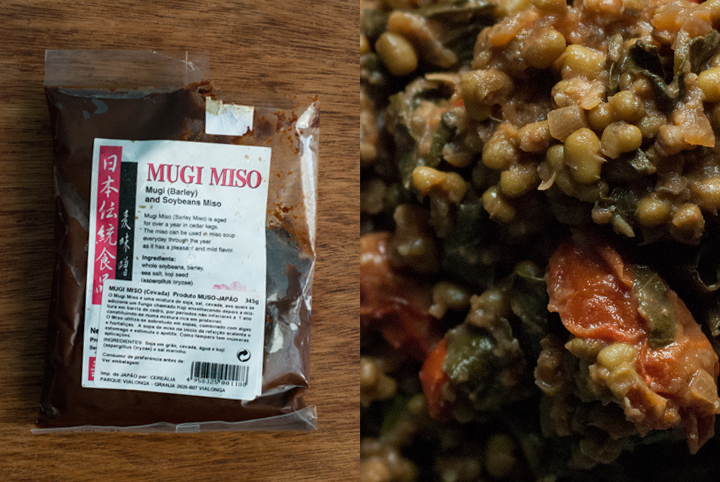
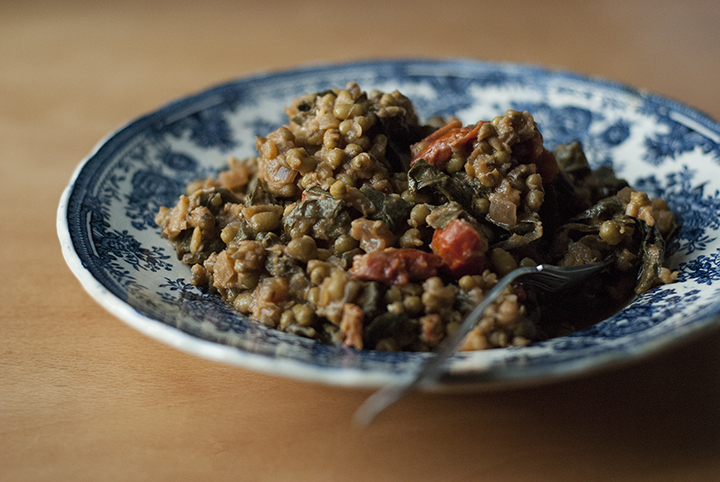
Mung Bean and Kale Stew with Miso
(serves 4-6 as a main)
1 tablespoon olive oil
1 medium sized onion, finely chopped
4 garlic cloves, finely chopped
1 big piece of ginger / 50 g, peeled and finely grated
260 g kale, coarsely chopped
270 g cherry tomatoes, cut the larger ones in half but leave the smaller whole
1 cup / 200 g mung beans
3 bay leaves
4 cups / 1 litre stock or water
4 tablespoons mugi miso
In a large sauce pan, heat the olive oil, onion and garlic over medium heat. Sautée for 5 minutes or until the onion has softened.
Add the cherry tomatoes to the pan and crush them lightly with the help of a wooden spoon, so that they release their juices. Add the bay leaves, kale and mung beans, followed by the stock. Raise the heat to high and bring the mixture to a boil. Once boiling, decrease the heat to low, cover the pan, and let the stew cook for 30 to 35 minutes, or until the beans are thoroughly cooked and the kale is tender.
After that time, take out the lid and let the stew cool down for 5 minutes – you’re going to add the miso to the pan and you don’t want to ruin its health properties by heating it up excessively.
In a medium sized bowl, add the 4 tablespoons of miso. Then, gently pour ½ cup of the stew’s liquid over the miso and whisk everything together until you get a sauce-like mixture with a smooth consistency. Add the miso mixture back to the pan and mix well to incorporate. Serve with cooked quinoa, crunchy bread, or simply topped up with plenty of roasted almonds.
Adzuki Bean and Celery Stew
Before we get into today’s recipe, happy new year to everyone! 2010 was a though year for me (both in the professional and personal realms), full of challenges and times when important decisions had to be made. It was also the year I cooked more, having learned from my both succeeded and not-so-well succeeded experiments in the kitchen, and the year I have also started this blog. I’m not a person of making life-changing resolutions or, more precisely, I don’t usually make them this time of the year (although I reflect, as I suppose we all do, about what the previous year has brought to me and what – and how - were its best and worst moments). Anyway, as I’m typing this I’m reflecting about a couple of things I’d like to do more – in culinary terms – in 2011. They’re not resolutions, only desires and things I hope I can accomplish. Those are: I’d like to cook more from cookbooks, studying even more non-vegan recipes and trying to come up with vegan alternatives; to master the art of gluten-free baking; to share more meals with friends and family and to cook more meals alongside friends and family; to have a more mindful way of eating, incorporating as much healthy choices as I can into my diet.
On another front, this year I’d like to run more regularly, to fight the tentation to cut my hair short again, to travel abroad (London and Berlin are on my upcoming travel plans), and to be even more surrounded by people whom I love and admire.
As far as today’s recipe goes, it’s basically an adaptation of this one. It’s a delicious and easy stew, perfect for the cold weather and that goes very well not only with toasted wholegrain bread, but also with some simply cooked quinoa. The recipe is easily doubled, which makes it also a very croud-pleasing dish. Hope you’re all having a great time, and I wish you a 2011 full of fruitful projects and ideas.
Adzuki bean and celery stew
(serves 4 to 6)
500 grams cooked adzuki beans*
10 canned whole plum tomatoes, drained, rinsed and roughly chopped
2 cups light stock
2 large heads of celery (stalks only, trimmed and sliced into 2cm thick chunks)
1 teaspoon celery salt*
4 large garlic cloves, peeled and thinly sliced
1 large white onion, peeled and finely sliced
4 tablespoons olive oil
1. In a large pan over medium-high heat, add the olive oil, onion and celery chunks and cook for 10 minutes, stirring often, or until the vegetables are soften. Add the garlic and 1 teaspoon of the celery salt and cook for additional 4 minutes.
2. Add the tomatoes, stock and the beans to the pan. Bring to a simmer and, once simmering, decrease the heat to low and cook, covered, for 20 minutes. Taste and season with a bit more celery salt if needed. Let the stew sit for a couple of minutes before serving.
*to make the celery salt: Pick a couple leaves (no less than 10) from the celery heads. Heat a dry skillet over high heat and add the leaves. Let them toast for 5 to 10 minutes, or until totally dried out. Then, crumble equal parts of the dried leaves with flaky sea salt. For better results, grind the mixture in a coffee grinder.
*to cook the beans: Soak the beans in a large amount of water for 6 to 8 hours or overnight. Drain and rinse them and put them in a large pot. Add water to come at least 2 centimeters over the beans. Bring the water to a boil and, once boiling, decrease the heat to low-medium and cook, covered, for 1 to 2 hours. Once ready, salt the beans and drain them – reserving a couple cups of the liquid in which they were cooked, that you can later use in preparations such as stews and soups. You can now use the beans, refrigerate them (they’ll keep, store in the refrigerator in an airtight container, for up to a week), or bag and freeze them.
recipe adapted from 101 cookbooks
Simple Vegetable Stew with Homemade Seitan Sausage
Seitan used to be one of those things I’d eat on rare occasions, as I was never a big fan of its taste. I liked its meaty, slightly chewy texture, but I felt I never marinated or seasoned it the right way, as everytime I’d prepare it, it would end up tasting a bit too bland. The only way I could eat this source of vegetable protein would be on a spaghetti bolognese sort of dish, where I’d grind it and cook it in unreasonable amounts of tomato sauce. But then I’ve bought The Millenium Cookbook and I found out I could make my own seitan, and add to it as much flavor as I wanted to. The original recipe from the book, has curry and spices such as cumin and coriander as dominant flavors. I’ve made that recipe a hundred times around here, until I started playing around with it a bit more. The recipe for the seitan sausages I’m sharing with you today, has dried herbs and tomato sauce as “flavoring agents”, to make it more of a provençal-inspired sort of thing.
As far as the preparation goes, let me tell you that seitan making has no special technique at all, and I’m sure that if you attempt at making it, you’ll be surprised by how easy it is. On the other hand, I bet that by the time you’re preparing it, you’ll have a lot of other ideas on how to flavor it differently. I’ve made a couple of notes on that too: adding seaweeds such as dulse or wakame to the gluten dough could be interesting, as well as finely cut vegetables, for a more distinct texture. On the same hand, I bet that adding a coulpe of drops of liquid smoke to the dough, would definitely please even the most conservative meat eaters out there. I added the sausages today to this simple vegetable stew, but feel free to try these in pasta sauces, pizzas, or in whatever dish you might think they’re a good addition to. The possibilities are endless, really, and I’m sure you can come up with better ideas for using it than I do. ; )
Update: Trudy, from VeggieNumNum, has made a wonderful version of these seitan sausages. You can find her version, as well as other stunning veggie recipes here.
Simpe Vegetable Stew with Homemade Seitan Sausage
For the Seitan Sausage
(makes 4 sausages)
2 cups (250 grams) gluten flour
1 teaspoon salt
2 fat garlic cloves, minced
1 large white onion, cut in half
¼ cup olive oil
1 cup water
4 cups light stock
3 tablespoons tamari
4 tablespoons tomato paste
1 teaspoon dried thyme
1 teaspoon dried oregano
1 teaspoon dried chives
1 teaspoon dried parsley
1 teaspoon garlic powder
½ teaspoon paprika
4 pieces of cheesecloth of 30×30 cm each (note: make sure the holes of your cheesecloth are very close. otherwise, you might have to double or triple the amount of cloth used)
1. In a large bowl, combine the gluten flour, dried herbs, garlic powder, and salt.
2. In another bowl, mix 1 cup of water with the olive oil, tomato paste, and 1 tablespoon of the tamari.
3. Slowly add the wet mixture to the dry mixture, and mix until you have a firm and elastic dough. Kneed the dough for 5 minutes, making sure there’s no flour left on the bowl.
4. Divide the dough into 4 equal portions. With your hands, roll out each portion into a log about 8 centimeters long, but don’t worry if it doesn’t look perfectly shaped - while cooking, the sausages will plump and get a perfect cilindric shape.
5. Cut 8 pieces of kitchen twine of about 6 centimeters long each. Place a piece of cheesecloth in your table or kitchen counter, and roll it tightly around one piece of the dough. Tie the ends of the sausage with kitchen twine (using one of the cut pieces for each end), to seal the sausage in the cheesecloth - it’s important that the dough is really tight and properly sealed, or it might fall apart while cooking. Repeat this proceeding with the remaining pieces of dough.
6. In a large pan, add the 4 cups of stock, garlic cloves, onion, and 2 tablespoons of the tamari, and bring the liquid to a boil. Then, add the sausages. Reduce the heat to low-medium and simmer, covered, for 40 to 45 minutes, or until the sausages are cooked through. Discard the onion and garlic cloves.
7. Remove the sausages from the pan, let them cool, and carefully remove the cheesecloth. The sausages will keep, stored in an airtight container with the cooking liquid, for up to 1 week.
For the Vegetable Stew
(serves 4, generously)
1 large aubergine, cubbed
1 large zucchini, cubbed
1 medium sized red bell pepper, thinly sliced
2 fat garlic cloves, minced
1 tablespoon coriander seeds
2 teaspoons red chili pepper, minced (with seeds)
1 large ripe tomato, peeled, seeded, and cubbed
1 and ½ seitan sausages (about 200 grams), sliced into rounds
2 tablespoons olive oil
¼ cup red wine
4 tablespoons tomato sauce (canned is fine)
salt and pepper to taste
chopped coriander, for garnish
1. With the help of a mortar and pestle, crush the coriander seeds.
2. Heat the olive oil in a large pan over medium heat, add the garlic, chilli, and coriander seeds, and fry for 1 to 2 minutes, or until fragrant.
3. Add the zucchini, aubergine, and tomato cubes, as well as the wine and tomato sauce, and simmer, covered, for 15 to 20 minutes, or until the vegetables are soft and slightly overcooked. Add the seitan sausage, give the stew a good stir, and cook for additional 5 minutes.
4. Add salt and pepper to taste and serve immediately, garnishing each serving with chopped coriander.
The recipe for the homemade seitan sausages is inspired by the Millenium Cookbook, published by 10 speed press, in 1998
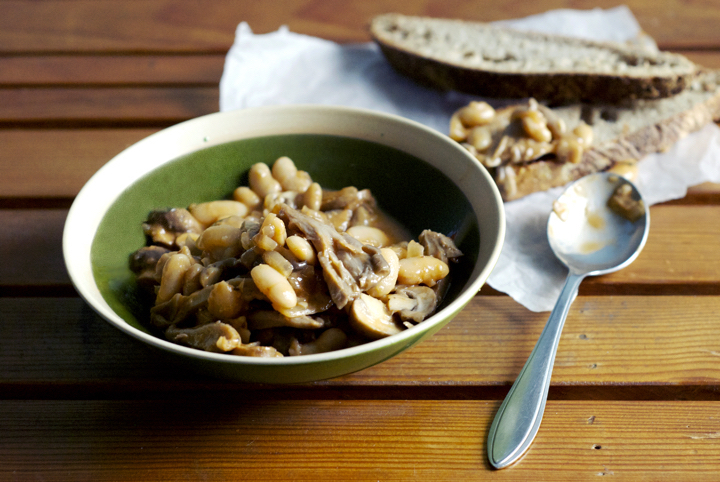
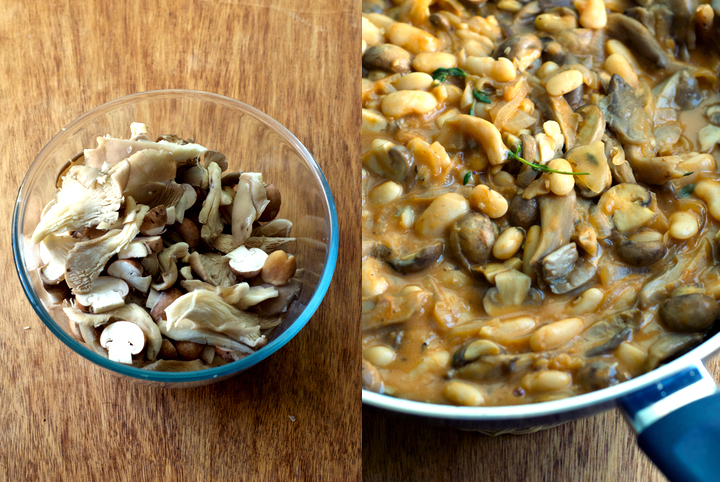
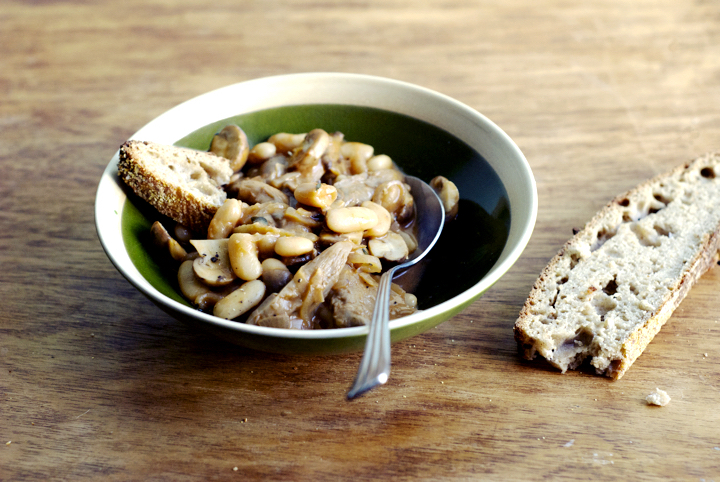
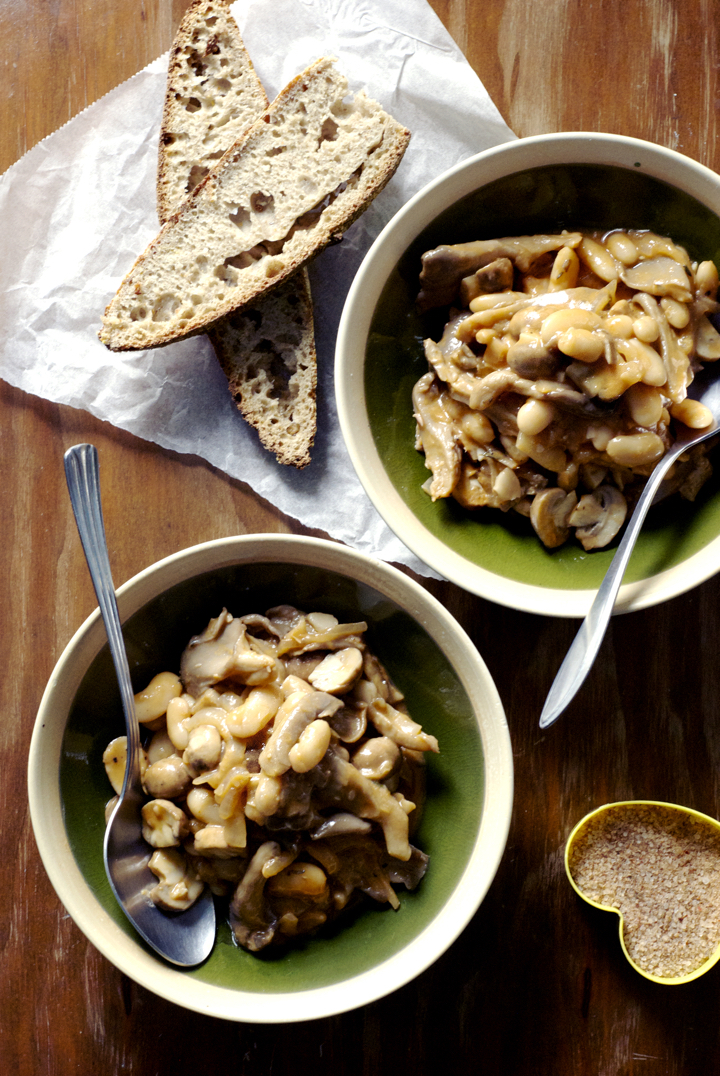
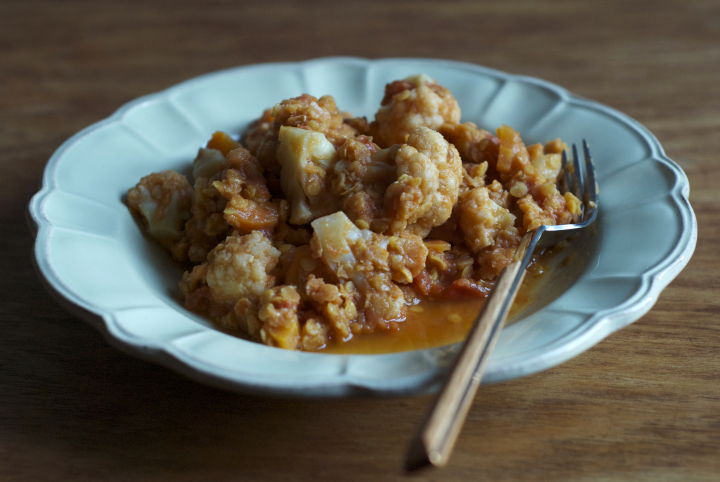
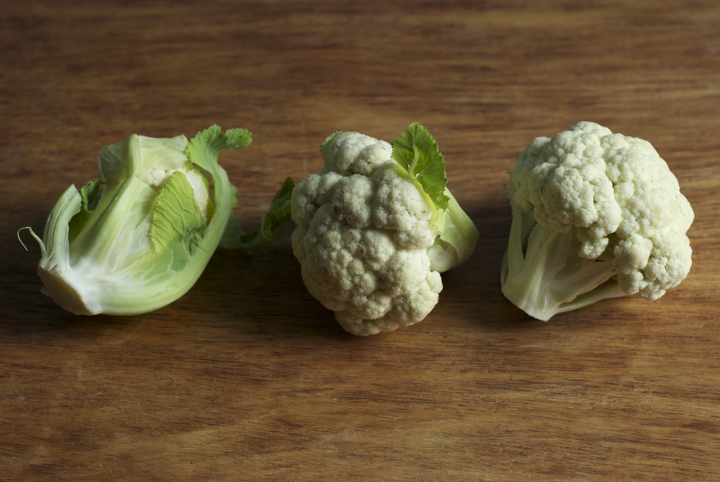
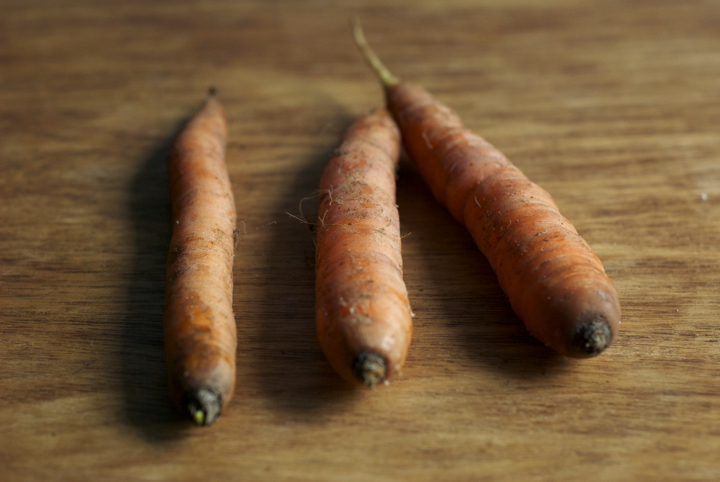
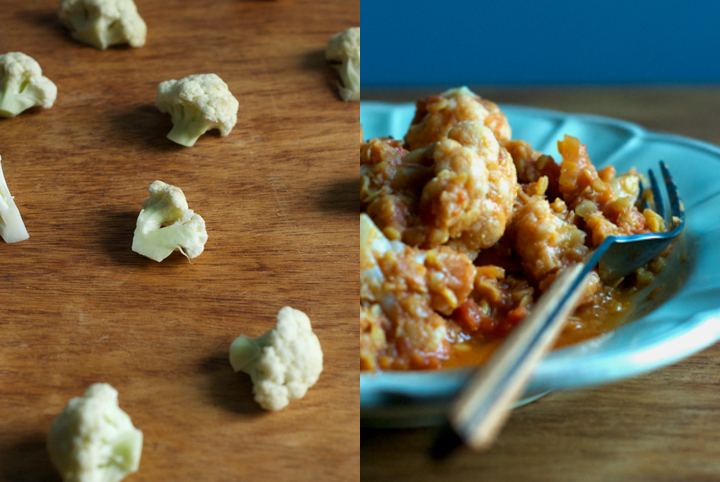

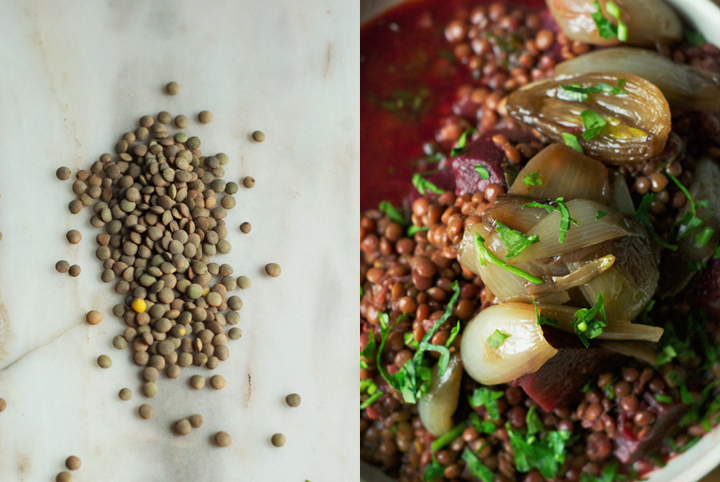
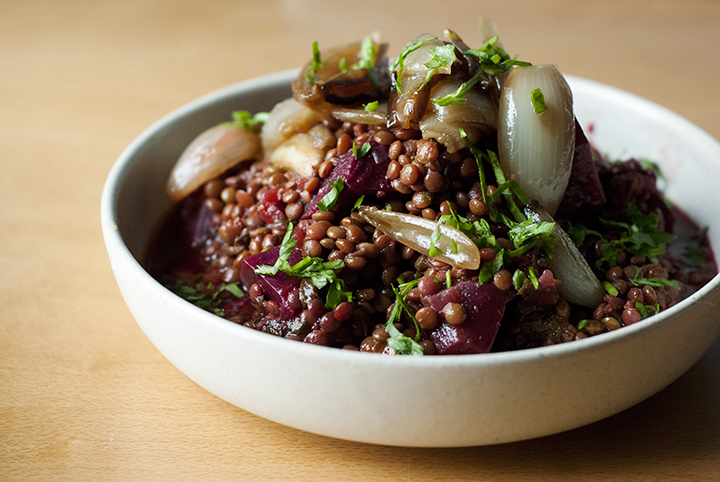
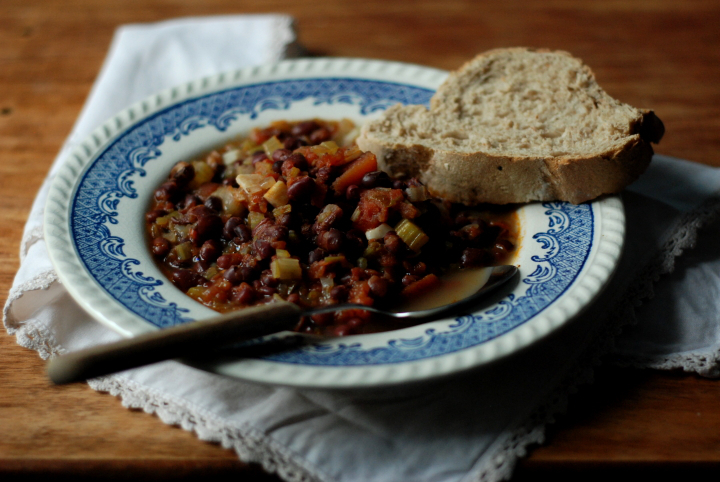
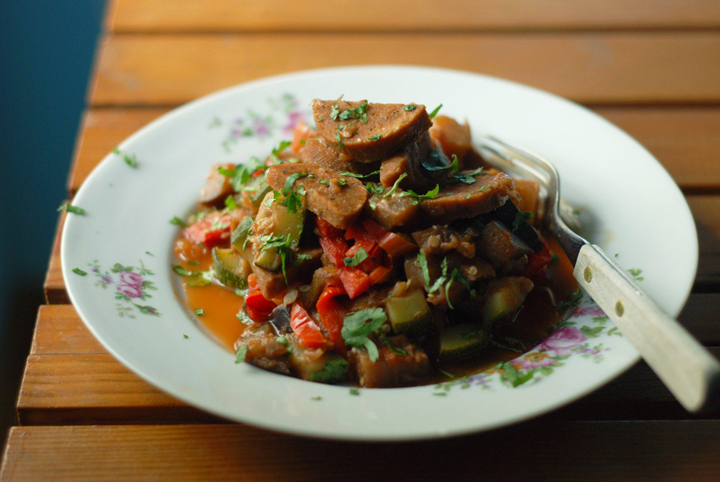
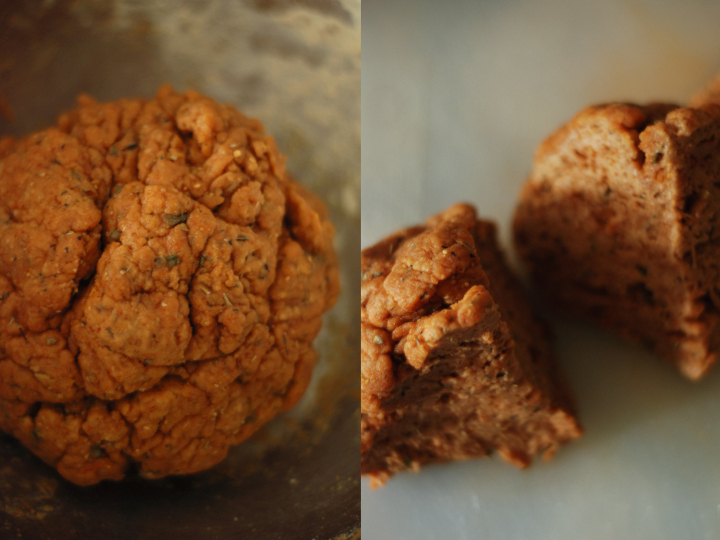
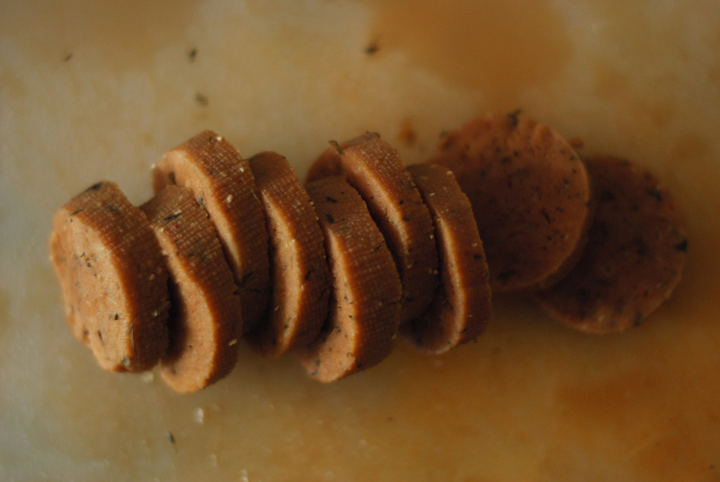
2 comments